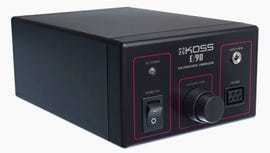The Koss ESP-950 electrostatic headphones debuted in 1990, so color me embarrassed — I’m a little late to the party. The good news is the ESP-950 is still being made, and this 26-year-old design is more transparent and spacious sounding than some of the best headphones I’ve reviewed over the past few years.

The Koss ESP-950 headphones
Koss
Most headphones use dynamic drivers that look like miniature dynamic speaker drivers; electrostatic headphones like the ESP-950 have larger, but lighter thin-film diaphragms suspended between electrically charged grids. Audiophiles have long admired electrostatic headphones (and speakers) for their highly transparent sound. The ESP-950 is an open-back, over-the-ear headphone, and its matching E-90 amplifier, are made in Koss’ Milwaukee, Wisconsin factory.
The headphone and amp are mostly made of plastic, so I was disappointed they don’t have the solid feel or look of high-end designs. On the upside, I found the ESP-950 comfortable to wear for extended periods of time. The tiny E-90 amp measures a scant 4.3 by 7 by 2.5 inches and works with its wall-wart power supply or the included battery-power supply for portable use. You also get a 6-foot headphone extension cable, and a handsomely designed leather carry bag for the headphone, amp, and accessories. The bundled price of the ESP-950 headphone and E-90 amp is $1,000 (the headphones aren’t sold separately).
The ESP-950 cannot be plugged into a standard 3.5mm or 6.3mm headphone jack; like all true electrostatic headphones, the ESP-950 can only be used with amplifiers designed for use with that variety of ‘phones.
The E-90 amp’s connectivity options are limited to the Koss electrostatic headphone jack, and two stereo inputs: a front-mounted 3.5mm input, and on the back of the amp, deeply recessed RCA inputs that won’t accept RCA plugs with thick connector barrels (the included RCA cables worked fine). The front panel’s volume control knob is split, with separate left and right channel controls, and that’s fine, but nearly every time I changed the volume I had to double-check to make sure the left and right channels were balanced.


The Koss E-90 headphone amplifier
Koss
Compared with some of the best headphones in my collection the ESP-950 sounded more open and spacious, less stuck inside my head. I loved that, and the midrange tonality was to die for. It’s so darn natural sounding, so voices, acoustic guitars and horns sounded more realistic than I’m used to.
Watching episodes of “The Knick” Cinemax TV series set in a New York City hospital in 1900, the sounds of horse-drawn ambulances, with hand-cranked sirens clomping down cobblestone streets were convincingly well played. The sound was so vivid it was easy to forget I was wearing headphones and just enjoyed the show.
Pitting the Stax SR-207 electrostatic headphones ($790 including matching amp) against the ESP-950, I heard very significant differences. First thing, the ESP-950 has a sweeter and fuller tonal balance. It also presents a bigger, more spacious soundstage; the SR-207 is nowhere as open. Both headphones sound remarkably clear and clean.
David Bowie’s live-in-concert “Stages” DVD-Audio sounded hugely spacious with the ESP-950, but switching over to my Audeze LCD-2 Fazor planar magnetic headphones ($995, not including amplifier) the bass blossomed, dynamic impact improved, and treble detailing was far superior. Bowie’s music rocked harder over the LCD-2 plugged into my Burson HA-160 headphone amp. With Bowie’s more ambient tunes like “Sense of Doubt,” the ESP-950 did a better job putting me inside the concert hall, so it was more like being there; the LCD-2 Fazor constricted and flattened the space. I liked both headphones for different reasons: the ESP-950’s massive soundstage and lifelike midrange trumped the LCD-2 Fazor’s, but the LCD-2 Fazor is much heavier and less comfortable, yet it did a better job with rock and other genres of bass-heavy music.
The ESP-950 is sold in the US with a limited lifetime warranty for the original owner, so if the headphone (or E-90 amp) has any problems , just ship it back to the factory (along with a check for $9 for return shipping), and Koss will repair or replace the headphones and/or amp. That level of lifetime customer service at no extra cost is extremely rare, and Koss is to be commended for that. So while the ESP-950 system is expensive, it’s an investment in good sound that you can enjoy for literally decades to come.
The Koss ESP-950 isn’t for every taste, but for those who crave truth and beauty over skull-crushing bass and riveting dynamics, this electrostatic headphone’s sound will be highly addicting.



